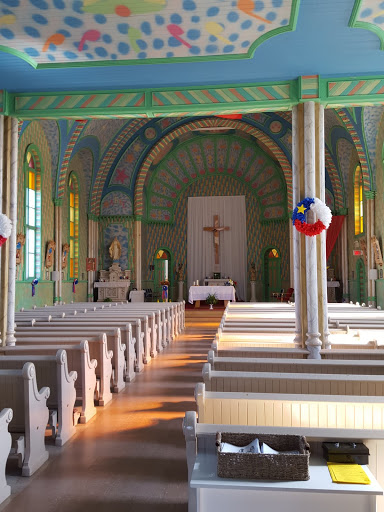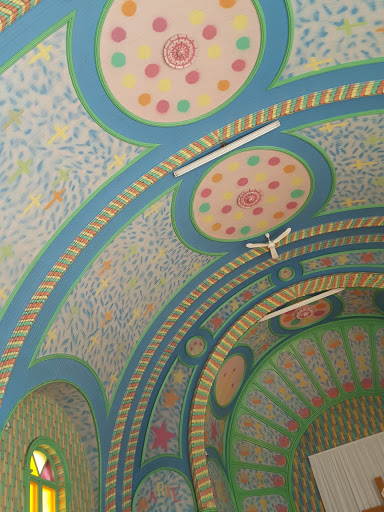On the northeast shores of Lamèque Island, New Brunswick, lies a folk art treasure. Sainte-Cècile Church, also known as the Candy Church, was built in the early 1900s.

Sainte-Cècile Church has excellent acoustics, and is the home of the Lamèque International Baroque Music Festival, held every year. This year was its 40th anniversary - it's the oldest Baroque music festival in Canada!
There's not much information online about New Brunswick's Candy Church, and while I was there, I was entranced by the interior - and thankful for a fellow visitor, translating the information for me from French. I reached out to our friends at New Brunswick Tourism for help. The following fascinating history is from Tourism New Brunswick:
History of the Candy Church
The church is dedicated to Saint Cécile, the patron saint of musicians.
Architect: Ludger Duguay (1860-1949), husband of Louise Duguay (1861-1948) from Pigeon Hill, on Lamèque Island.

Inspired by Roman architecture, construction of this sweet little wooden church began in 1910; it was completed in 1913. Although it has quite a sober look from the outside, the rounded shapes of its interior confirm the building's overall unified style. The entire structure is made of pine from Columbia. The trim work and architectural features, which were originally painted white, gave it the lofty look of a princely Scandinavian residence. The pillars, columns, and lateral pews and alters were painted in trompe l'œil, or imitation wood grain, a popular style at the turn of the 20th century. Unfortunately, with the passage of time, the linseed oil darkened and turned a dark, dreary brown, almost black colour. As the process of cleaning the entire interior of the structure was a daunting prospect, Reverend Gérard d'Astous opted to paint over everything, giving free reign to his creative imagination.
The work began on November 11, 1968. It was supervised by the Reverend, with assistance from Paul Gauvin of Petit-Lamèque and Léonce Lanteigne of Pointe-Alexandre. At the end of December that same year, most of the church had been repainted. As his two assistants had left, Father d'Astous finished the work himself. The job was completed in the spring of 1969. Since that time, the lateral pews and altars have been repainted, masking this original, magnificent work of folk art. As for the monochromatic Stations of the Cross, they were repainted just a few years ago.
Upon entering the vestibule, visitors will marvel at the naive style of the decor; trees are painted on the lower part of the walls representing the earth, the blue of the upper walls represent the sea, and the two pillars make reference to the local economy. Because the walls of the two stairwells leading to the choir loft cannot be seen inside the church, the first sketches of the work to be done was drawn on them, in a sort of dry run, in order to hide any errors and assess the scale of the enormous naive, fragmented fresco.

Upon crossing the threshold, symbolic iconography representing bells and musical notes can be seen on the ceiling, under the choir loft. The symbols warmly invite the faithful to come worship in this temple dedicated to Sainte-Cécile, the patron saint of musicians. An iconographic reference to the Ten Commandments represents the teaching of the word of God. Home to fervent prayers and deep faith, the church is also home to joyful meetings and celebrations; its explosion of vibrant colours is a testament to life itself.
Along the outside edge of the choir loft, a large star and some candle sticks represent the birth of Christ, our spiritual guide who brings light into our lives and guides us throughout our lives. In the nave, at the base of the wall, the dado is a textured grey colour producing the effect of imitation granite, symbol of the rock-solid foundations of the church. This subtle motif represents the dust from which we are all created.
The overall decor of the nave consists of a continuous multi-coloured motif of vertical, narrow bands painted in pastel colours, creating an unexpected illusion of upward movement. This main section symbolizes the good deeds we have done throughout our life on earth and our generous offerings to our Father.

The ceiling features motifs consisting of little crosses arranged in star-like groups against a misty-blue background, representing life's hardships and the end of human life when the soul is separated from the body.

The blue ceiling, with its balloons and birthday cakes, symbolizes a blessed eternity and the reward promised to the faithful who have obeyed the Commandments.
The sanctuary's decor is very similar to that of the nave, with one exception. Here, the liturgical iconography focuses on Eucharistic symbols: ciboria, hosts, grapes, and candelabras, all of which set off the rounded shapes of the ceiling arches.

One last but important detail involves the sky-blue background behind the statues of the Virgin Mary and Saint Joseph. Behind the statue of the latter, the sky is blue and partially cloudy. But behind the statue of the Virgin Mary, little paths criss-cross the sky, signifying that grace is granted through the intercession of the Virgin.


Have a look inside the church and feast your eyes on Father d'Astous' beautiful work.

To find the Candy Church
From Miscou Island (you'll want to visit the lighthouse, and eat at Steve's), cross the bridge south to Lamèque and take a right on route 313. You'll go past a few curves, and it'll be on the left. It's an unassuming church, so slow down when you think it's about time.
If you're coming from the south, from the mainland, take the bridge from Shippagan and turn left at Lamèque, onto the 313.

Pin for later:

Photos courtesy and copyright Wandering Educators
